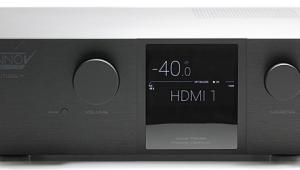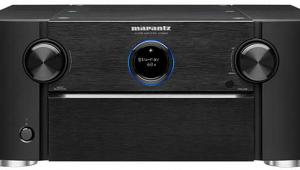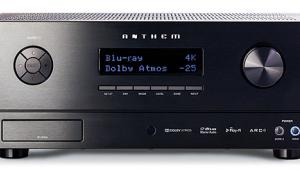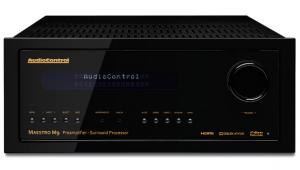I got an XMC-1 and I do agree with the sound quality being "Decision 1". I love the sound of the unit; best of all, it has reference quality analog audio (balanced XLR/RCA) path for reference audiophile two channels listening. I hope Emotiva keeps its promise on making the XMC-1 "completely modular and up-gradable to meet future standards."
Emotiva XMC-1 Surround Processor Review Page 2
However, there was certainly more going on than that. With Dirac engaged, reverberations sounded, not louder, but deeper, smoother, or shall I say, creamier, and perhaps even very slightly longer. Transients also were distinctive. The finger-snaps that open Diana Krall’s “My Love Is” clearly demonstrated both a more percussive snap and a richer, longer-seeming reverb tail. On the finger-snaps and on elements such as plucked acoustic guitar, harpsichord, and hi-hat ticks, transient leading-edges seemed highlighted—more prominent and snappy while not actually louder, as if richer in top-octave harmonic content, despite the fact that Dirac rolled off the top two octaves by a decibel or more.
 Imaging, too, was different. Dirac shifted the Krall tune’s finger-snaps to dead center, from slightly left (where they appeared in non-Dirac playback), and made a perceptible sharpening of image location on a wide variety of recordings. For example, a rich but fairly diffuse rendering of Elgar’s Symphony No. 1 (an HDtracks download) enjoyed a noticeably tighter soundstage—which also seemed slightly deeper, and at the same time a bit narrower, or at any rate not wider in proportion.
Imaging, too, was different. Dirac shifted the Krall tune’s finger-snaps to dead center, from slightly left (where they appeared in non-Dirac playback), and made a perceptible sharpening of image location on a wide variety of recordings. For example, a rich but fairly diffuse rendering of Elgar’s Symphony No. 1 (an HDtracks download) enjoyed a noticeably tighter soundstage—which also seemed slightly deeper, and at the same time a bit narrower, or at any rate not wider in proportion.
One unexpected but subtly dramatic Dirac effect was one I simply stumbled across: On an ordinary Red Sox broadcast, the background crowd noise, which normally sounds more like a distant waterfall, became subtly more granular and lifelike, letting me more easily pick out the occasional distinct voice from the general ballpark buzz.
I spent an hour or more with my treasured copy of The Sheffield Drum Record (on CD), where Dirac clearly moved the kit into a more convincing and subtly more lively acoustic space—and this is a fairly tight studio recording. But here and throughout, my impression of enhanced brightness that wasn’t really brighter remained, and it grew even stronger when invoking Dirac over multichannel music via Dolby PLII/Music. Enough so that I went back to Dirac Live on the laptop and jiggered my target curves for all five channels, knocking everything down an additional 1.5 to 2.5 dB or so, from 1,500 Hz to 15 kilohertz. Repeating my listening, I heard, essentially, no change at all: The brighter, or perhaps clearer, or more sharply focused sound and the deeper or stronger ambience elements remained. Of course, what acted as a boon on better-quality recordings was not always advantageous on inferior ones like Bruce Springsteen’s Greetings from Asbury Park, N.J., where a clearer window onto bright ’n’ spitty wasn’t necessarily a good thing. Happily, defeating Dirac was never more than a key press away.
Dirac can operate upon discrete-multichannel modes like Dolby TrueHD and DTS-HD Master Audio (though not on direct DSD playback from SACDs, which the XMC-1 also can perform). Interestingly, I found much less obvious impact on movie soundtracks, except on prominent music cues. Dialogue and most ambience effects seemed relatively untouched. My speaker suite is quite neutral, especially through the vocal octaves, which may help to explain this: Little if any response correction is required (or seen, on the Dirac plots) in this range, and dialogue, being monaural to the center channel, may perhaps be less subject to correction.
There’s more to the XMC-1 than just Dirac, of course. Sound quality on straight (un-Dirac’d) movie or music playback was without blemish. (And I noted zero coloration on movie dialogue or TV announcers, centered or stereo, from Dirac engagement.)
The preamp accepts streaming audio up to 192/24 via a rear-panel USB port, so hi-res audio listening is a built-in option, though the XMC-1 has no music-server client functions of its own, working simply as a conventional asynchronous USB-DAC/preamp. (Direct DSD playback via USB is not supported—firmware update, anyone?)—but my DSD library played fine once converted to PCM by my Mac’s software player.
My other stereo hi-res tracks from my iMac streamed as well, though neither my software players’ “talkback” display nor the XMC-1’s own display ever showed a sampling rate greater than 48 kHz, despite playing files designated at 88.2, 96, or even 192 kHz. I initially took this to mean the Emotiva was decimating everything to 48 kHz (except native 44.1 stuff, which played at 44.1 kHz), and I could discover no setup option or control to manage this.
Emotiva’s in-house expert eventually became convinced that my long 16-foot USB cable was screwing up communication between my computer/player software combo and the C-Media CM6631A chip inside the XMC-1, which is said to be sensitive to timing that’s affected by cable length and the architecture of USB ports. In my case, it was surmised, the unsuccessful “rate-negotiation” suggested to my software that the XMC-1 was only a modest one-bedroom in the low-rent district instead of the high-end villa on the Riviera that it really is, so the player would send only the best quality it thought the pre/pro could handle. Emotiva recommends keeping USB cable length to two meters max, but the best I could do with my physical setup was swap in a 12-footer, which offered no improvement. Nor did switching the player software from Audirvana to any of several others I have resident. In any event, I’ve never had this issue before with any direct connection of my Mac (running OSX 10.9) to any DAC; the same cables running to a Micromega MyDac results in successful playback up to the maximum specified 96 kHz. Be warned.
This is as good a place as any to observe that, besides its automated Dirac corrective equalization, the Emotiva’s two additional memory registers each store an 11-band parametric arrangement for every individual channel, all 7.2 of them, with each band having independent adjustment of frequency, boost/cut, and Q (bandwidth/shape). This is a lot of processing firepower, enough for any of us to make things almost certainly worse by fiddling by ear and eye. Emotiva conceives these as mostly useful to the seriously techno audiophiles who wish to run an independent (non-Dirac) speaker/room-correction application, such as the popular Room EQ Wizard—or even perform measurements the old-fashioned way with SPL meter, pad, and pencil—and then enter the derived parameters manually. For those Luddites, the XMC-1 even incorporates built-in pink-noise and sine-wave signal generators.
Of more practical use, in my view, Emotiva endows the XMC-1 with unusually flexible tone controls, which can be applied globally or by individual input. Better still, Emotiva puts Center-Surround-Sub-Back channel-level trims—each with gloriously dedicated, hardware up/down key pairs—right on the XMC-1’s big remote, where they belong. Such rapture! These offer 0.5-dB adjustability and re-zero with each input change, a sensible, simple design expedient.
Emotiva claims the XMC-1’s front-panel headphone output is an amply powerful, high-quality circuit, and my listening seemed to confirm this. Thoughtfully, a completely independent set of channel-level and tone-control settings is recalled when you plug in the cans. And the XMC-1’s 12-volt-trigger-setup matrix even includes headphone presence (physically sensing a plug in the jack) as an option, enabling auto-powering-down of amps, or any other trigger-induced automation you can dream up. (These guys had their thinking caps on.) However, all multiband EQ processing, whether Dirac or manual, is defeated with ’phones connected. The mandate for the Dirac defeat is obvious, but likewise locking out the manual-EQ presets mystifies me; how cool would it be to have high-performing stereo-11-band PEQ to season your personal listening space to taste?

Lest I forget, the XMC-1 is a tuner-preamp, with onboard AM/FM reception and RDS display (but not HD Radio). And while it’s no dx-ing record-setter, the tuner doesn’t suck.
The remote that Emotiva supplies with the XMC-1 is a big, heavy, imposingly machined metal handset. It’s nicely laid out, with sensible key groupings and generous spacing. And there are lots of dedicated key pairs: In addition to the aforementioned and much-loved-by-me level trims, there are tuner seek, preset, and tune up/down pairs, as well as listening-mode, input, and (of course) volume, plus the usual four-way cursor grouping, and dedicated direct-access buttons for eight inputs.
The remote isn’t perfect, though (even if its magnetically secured rear battery cover is undeniably cool). I understand the high-end imperative for specialness, but I found the metal remote too heavy for comfortable single-handed ops, and there’s no lighting at all, a challenge in a home-theater environment (though the wide key spacing and varied shapes make by-feel operation possible, with time). And such custom, metal fabrication can’t come cheap; might not an off-the-shelf OEM remote (with backlighting) have shaved quite a few bucks off the MSRP?
One remote key, Loudness, demands special mention. This (or a setup option) transforms the pre/pro’s volume control from a simple attenuator to a true “loudness” control. Thus empowered, as it reduces volume from an (unspecified) unequalized reference point, it imposes equalization progressively as the setting declines, to compensate for human hearing’s deficiencies at softer-than-real-life amplitudes; this is an outstanding design concept. (Autobiographical note: We incorporated exactly this sort of control action, also optionally, in the Apt/Holman preamplifier, when I worked for that company about a zillion years ago.) Emotiva would get an A+ if they had based it upon more modern loudness studies (S. S. Stevens) rather than the familiar but outdated Fletcher-Munson curves they referenced. Still, it’s a back-to-the-future, honestly real-world-useful, feature. Bravo!
OK, I’m out of space and time—as might have said Paul Dirac, the English quantum physicist for whom the Swedes may have named their company. So here’s the executive summary: Emotiva’s XMC-1 is an intelligently engineered, fine-sounding A/V pre/pro with quite a few clever extras, almost all of them contributing genuine value in enhancing the audio or user experience. Its marquee feature, Dirac Live, seems to me to have real worth to those prepared to delve deeply and carefully enough to glean it. In all frankness, this issue’s short publication cycle has kept my own explorations fairly close to the surface so far, but Dirac definitely has my attention.
As does Emotiva, for the XMC-1 surround processor. It’s a high performer and an honest high- end value.
- Log in or register to post comments


I'm an Emotiva fan and have lots of their stuff. However, my UMC-200 (now discontinued) doesn't have auto lip sync and to my knowledge this $2000 unit doesn't either. Yes, you can manually adjust it, but how old do you think that gets? The best audio quality in the world isn't worth a dime if it's out of sync.
Note to Emotiva - auto lip sync is a requirement.

I have the XMC-1. I don't have limpsync problems. I am not sure about the UMC-200. You could check their forums emotivalounge.proboards.com --or call Emotiva support for a solution. The timing is taking off the video via HDMI protocol. Maybe your TV/projector is doing heavy processing causing a delay hance sync problems.

type-o it's "Lip-sync"

I left my Lip sync at "Auto" and don't have a problem. Do you have any post processing video devices? No? Try defeating all video processing on your display. The HDMI works on video timing hence the sync in audio with video.

How would you compare these room correction systems??
What frequency does Dirac do its corrections at?? Audyssey does it at 48khz, ARC at 96khz.
It was a little unclear to me if you can do two separate corrections. In ARC you can do a separate 'movie' and 'music' configurations, which is great if you use different speaker configurations-- 7.1 and stereo 2.1 for instance.
I got the impression that you need to set each speaker level to 75db and enter each speaker distance before running Dirac. Is that correct??
If so how precise are the measurements?? To the foot? 1/2 ft.?, inch?
Am I correct in understanding that it does not balance dual subs prior to doing its room correction like Audyssey XT32 does, but the subs need to be balanced either with an outboard system like DSPeaker antimode 2.0 or similar component.
What is your reference pre/pro? it will say a lot about the XMC-1's audio. Are you comparing to an Integra 80.3 or an Anthem D2v?
Lots of questions, but I'm interested to find out more about the XMC-1 and Dirac.

Actually Audyssey is completely dependent on the hardware of the component. It can do processing up to 96kHz if the necessary DSPs are present, but in every implementation I've used it only goes up to 24kHz because of the lack of DSP processing power for it. Also Audyssey XT32 only does dual subs if it also includes SubEQ HT. Most XT32 components have it, but it's not a requirement for XT32.

Dirac is also taxing on the DSPs. I am not sure if it decimates PCM down to 48Khz like the usual Audyssey implemented, but 48Khz sampling rate is still above full-range. What system you had that goes up to 24Khz?
https://en.wikipedia.org/wiki/Sampling_(signal_processing)

I meant it has a sample rate of 48kHz so it only works out to 24kHz. Dirac on the Emotiva works the exact same way.

I recently learned that Audyssey only decoded up to 48khz/16 but. Is that true? Because that would seem to render any hi rez content completely moot.
Also, how can it do processing up to 96kHz with the "necessary DSP"? Could you expand on that if you don't mind?

Audyssey typical implementation usually down-samples to 48Khz/24Bit if native file is 24bit. I am not sure about 16bit, but it's up to the AVR manufacturers DSPs implementations.

According to Audyssey, there is nothing about Audyssey that causes it to be limited to a 48kHz sample rate. Sample rates up to 192kHz or even beyond would be supported. Since correction to 96kHz or 192kHz takes at least 2x or 4x as much processing power as to 48kHz, manufacturers would need to install 1-2 more DSP units to be able to do this. Since most people don't care, and if you can hear that difference is up for debate, it isn't worth it to the companies to support this. So someone could do this, but their unit would cost more than other models with similar features, and it's a feature more people wouldn't understand when they're trying to sell it.

That certainly makes any disc that is 96/24 multi channel essentially worthless. What a total downer if you're looking to listen to hi rez content.... Does anyone know if it decodes full resolution (196/24) in 2 channel??

The implementation of Audyssey on most audio equipment only allows 48khz sampling rate @ 24bit. The reason is because 48khz sampling rate it could reconstruct frequencies up to 22 kHz. Typical human ears could only hear up to 20Khz; hence, giving an AVR extra DSP power at greatest cost for something that most people in the planet wouldn't notice is efficient.
The issue would be how it Audyssey decimates higher PCM sampling rate files of 88, 96 or 192khz down to 48Khz. This computer code could negatively affect sound quality; since now, the native "sound" or bits of the PCM file is being re-sample on the fly to 48Khz. This is one of many reasons most audiophiles don't use EQ and only listen to stereo --but this is all preference.

I have had two of their preamp processors and they are just not reliable over more than a year. My second would not output to the subwoofer...sent it back..yet they were unable to fix it and finally got my full money back...

Emotiva has a five years warranty on most of their equipment. This show how confident they are about their build quality --but I am glad you got your money back.

For highend processors I wish the reviewers would compare the DAC preformace against a known high performer like the OPPO 105. I need to get a new processor but also need to upgrade my Blu-ray. Which would sound better for audio performance... analog input from a 105 or digital input from the OPPO 103?

John, it would be hard to tell the deference between top-of-the-line DACs. The Oppo 105 is an excellent player, but you're looking to update, right? Well, UHD BluRays should be out by the end of the year. If I were you, I would wait. Get something with the latest technology; so you don't need to upgrade again.
The XMC-1 has Dirac which helps with movies, games, music room EQ. It would get HDMI 2.0a, once the standard is set in stone. This mean your new UHD BluRay player would be support once is out. The XMC-1 as analog in. You could use the DAC in a BluRay player like the Oppo. You're ears will tell you which is "best".
In addition, Emotiva said they will keep updating the XMC-1 unit to keep up with the times. I am not sure what this means, but time will tell.

This is John again. My real qustion was intended to elicit a comparison of the XMC-1 Dac versus a well known DAC as is in the OPPO 105. If the XMC is superior then I would not waste the extra money on a more expensive Blu-Ray (UHD or not). I wish reviewers compared the analog input versus digital/HDMI inputs on high end procesors. That simple comparison could save guys like me hundreds of dollars (much more including RCA cables) if the processor digital input and DAC coversion is as good as the analog outputs of high end players like the OPPO 105. Thanks!

In theory, the DAC in the Oppo 105 is better; however, it all depends on the execution on how Oppo implemented the SABRE DAC in their BRP. My understating, it’s the best Blu-Ray player in the world, with the best DAC in the world, on paper. Since, they’re zero comparison between XMC-1 and Oppo 105 sound quality; weight your decision on the feature it brings.
XMC-1 is a processor, so it will give your room EQ, like Dirac, REW support, many HDMI connections, etc. You could use the Oppo 105 as a ‘baby’ processor, but it would scarce the extra HDMI for your other components, room EQ, etc.
If I were you, I would get a processor; and latter get the following Oppo model to the 105, with native 4K, once money allows. The 105 soon will be replaced with a native 4K model. The XMC-1 will be there for some time to come.
“I wish reviewers compared the analog input versus digital/HDMI inputs on high end procesors.”
The analog input in the XMC would bypass the DAC in the XMC-1 and it would use your source’s DAC (Oppo). This is helpful; because it “future proof” the unit by allowing you to use newer/better DACs. Using the HDMI in the XMC-1, would use the DAC in the XMC-1. As far as cables, just get nice build quality cables, and don’t fall for the snake-oil marketing of cable makers. Talk to any electrical engineer or recording studio processional. They don’t use fancy brands cables with exotics “features”: why is that? lol
Anyway, what will you pair the oppo/processor with?

If the XMC-1 did NOT offer a step-up in SQ over the Oppo 105 then I think there would be something wrong with Emotiva's value proposition. After all, it is a dedicated pre/pro (plus tuner) costing significantly more than the Oppo, which is a multi-function device.
By the by, as an Oppo 105 owner I don't think its DAC implementation is anything special, however it may look on paper. Connecting its stereo co-ax output to an external DAC (in my case Metrum Octave Mk I) produces a marked improvement in energy and overall SQ compared to the Oppo's rather lazy delivery.
As a pre/pro the Oppo is also quite basic, with limited functionality that omits any equalisation, dialogue lift, etc, or varying crossover points for each speaker.
For all that, it would be interesting to know how the XMC-1 and 105 compare on SQ, back to back (when the Oppo is used as a source)....


























































